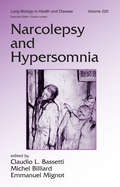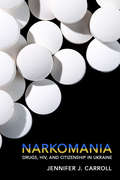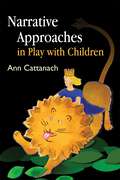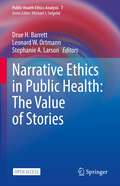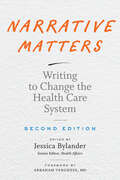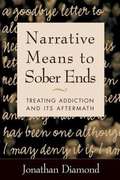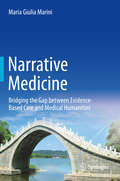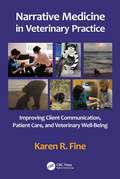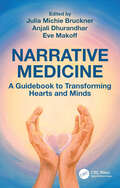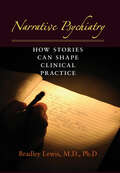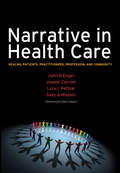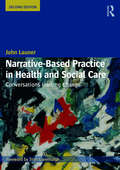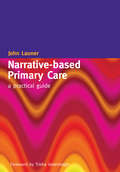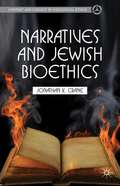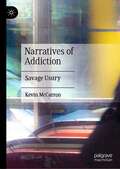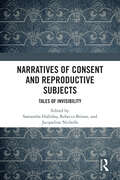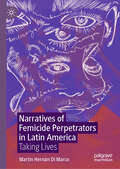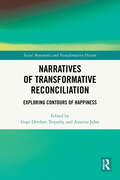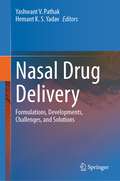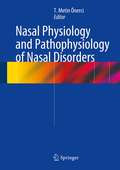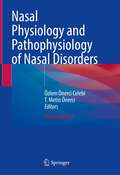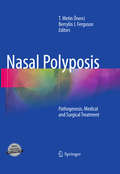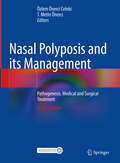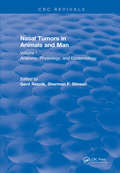- Table View
- List View
Narcolepsy and Hypersomnia (Lung Biology in Health and Disease)
by Michel Billiard Claudio L. Bassetti Emmanuel MignotCompiled by an international group of more than 40 authors, this reference book supplies an engaging and comprehensive review of the major topics and key issues associated with narcolepsy and hypersomnia. Spanning the latest advances in the field, this source covers current diagnostic procedures, genetic developments, explorations of animal models,
Narkomania: Drugs, HIV, and Citizenship in Ukraine
by Jennifer J. CarrollAgainst the backdrop of a post-Soviet state set aflame by geopolitical conflict and violent revolution, Narkomania considers whether substance use disorders are everywhere the same and whether our responses to drug use presuppose what kind of people those who use drugs really are. Jennifer J. Carroll's ethnography is a story about public health and international efforts to quell the spread of HIV. Carroll focuses on Ukraine where the prevalence of HIV among people who use drugs is higher than in parts of sub-Saharan Africa and unpacks the arguments and myths surrounding medication-assisted treatment (MAT) in Ukraine. What she presents in Narkomania forces us to question drug policy, its uses, and its effects on "normal" citizens.Carroll uses her findings to explore what people who use drugs can teach us about the contemporary societies emerging in post-Soviet space. With examples of how MAT has been politicized, how drug use has been tied to ideas of "good" citizenship, and how vigilantism towards people who use drugs has occurred, Narkomania details the cultural and historical backstory of the situation in Ukraine. Carroll reveals how global efforts supporting MAT in Ukraine allow the ideas surrounding MAT, drug use, and HIV to resonate more broadly into international politics and echo into the heart of the Ukrainian public.
Narrative Approaches in Play with Children
by Ann Cattanach Alison WebsterNarrative play is a way of communicating with children using imaginative stories and narratives to share and make sense of life events. This book describes using narrative play therapeutically with children who have lived in multiple families, children who have problems with social understanding and children who have learning difficulties. Ann Cattanach explains how children's stories and narratives, whether they are about real or imagined events, can be interpreted as indicators of their experiences, their ideas, and a dimension of who they are. She demonstrates this with examples of children's stories from her clinical experience, and provides narrative play techniques and sample scripts both for therapists and for parents whose circumstances require a therapeutic parenting approach. This book is essential reading for play therapists, social workers and other professionals working with children, as well as parents and carers of children who are experiencing social and/or learning difficulties.
Narrative Ethics in Public Health: The Value of Stories (Public Health Ethics Analysis #7)
by Drue H. Barrett Leonard W. Ortmann Stephanie A. LarsonThis Open Access book illustrates the power of stories to illuminate ethical concerns that arise in public health. It complements epidemiological or surveillance evidence, and reveals stakeholder perspectives crucial for public health practitioners to develop effective and ethical public health interventions. Because it relies on the natural and universal appeal of stories, the book also serves to introduce the field of public health to students considering a career in public health. The opening section of the book also serves as a more didactic introduction to public health ethics and the field of narrative ethics. It describes the field of public health ethics including ethical principles relevant to public health practice and research, and the advantages of a narrative ethics approach. That approach explores the problems and the ethical challenges of public health from the inside, from the perspective of those experiencing health problems to the challenges of those who must address these problems. The later sections consist of 14 chapters that present the actual stories of these public health problems and challenges. In narrative style they range from first person narratives of both practitioners and citizens, to analysis of published short stories. The problems and challenges they address include issues relating to justice concerns, surveillance and stigma, community values and the value of community, trust and the value of information, and freedom and responsibility. Specific public health topics include resource allocation, restricting liberty to protect the community from health threats, and the health impact of trauma, addiction, obesity and health disparities.
Narrative Matters: Writing to Change the Health Care System
by Jessica BylanderDrawn from the popular "Narrative Matters" column in the journal Health Affairs, these essays embody a vision for a health care system that centers the humanity of patients and doctors alike.Health care decision making affects patients and families first and foremost, yet their perspectives are not always factored into health policy deliberations and discussions. In this anthology, Jessica Bylander brings together the personal stories of the patients, physicians, caregivers, policy makers, and others whose writings add much-needed human context to health care decision making.Drawn from the popular "Narrative Matters" column in the leading health policy journal Health Affairs, this collection features essays by some of the leading minds in health care today, including Pulitzer Prize–winner Siddhartha Mukherjee, MacArthur fellow Diane Meier, former Planned Parenthood president Leana S. Wen, and former secretary of health and human services Louis W. Sullivan. The collection also presents important stories from lesser-known voices, including a transgender doctor in Oklahoma who calls for better treatment of trans patients and a palliative care physician who reflects on how perspectives on hastening death have changed in recent years. A foreword written by National Humanities Medal recipient Abraham Verghese, MD, further rounds out the book.The collection of thirty-two essays is organized around several themes:• the practice of medicine • medical innovation and research• patient-centered care• the doctor-patient relationship• disparities and discrimination• aging and end-of-life care• maternity and childbirth• opioids and substance abuseContributors: Louise Aronson, Laura Arrowsmith, Cheryl Bettigole, Cindy Brach, Gary Epstein-Lubow, Jonathan Friedlaender, Patricia Gabow, Katti Gray, Yasmin Sokkar Harker, Timothy Hoff, Carla Keirns, Raya Elfadel Kheirbek, Katy B. Kozhimannil, Pooja Lagisetty, Maria Maldonado, Maureen A. Mavrinac, Diane E. Meier, Dina Keller Moss, Siddhartha Mukherjee, Donna Jackson Nakazawa, Travis N. Rieder, Aroonsiri Sangarlangkarn, Elaine Schattner, Janice Lynch Schuster, Myrick C. Shinall, Gayathri Subramanian, Louis W. Sullivan, Gautham K. Suresh, Abraham Verghese, Otis Warren, Leana S. Wen, Charlotte Yeh
Narrative Means to Sober Ends
by Jonathan DiamondWorking with clients who abuse drugs or alcohol poses formidable challenges to the clinician. Addicted persons are often confronting multiple, complex problems, from the denial of the addiction itself, to legacies of early trauma or abuse, to histories of broken relationships with parents, spouses, and children. Making matters more confusing, the treatment field is too often splintered into different approaches, each with its own competing claims. This eloquently written book proposes a narrative approach that builds a much-needed bridge between family therapy, psychodynamic therapy, and addictions counseling. Demonstrated are innovative, flexible ways to help clients form new understandings of what has happened in their lives, explore their relationships to drugs and alcohol, and develop new stories to guide and nourish their recovery.
Narrative Medicine
by Maria Giulia MariniThis book examines all aspects of narrative medicine and its value in ensuring that, in an age of evidence-based medicine defined by clinical trials, numbers, and probabilities, clinical science is firmly embedded in the medical humanities in order to foster the understanding of clinical cases and the delivery of excellent patient care. The medical humanities address what happens to us when we are affected by a disease and narrative medicine is an interdisciplinary approach that emphasizes the importance of patient narratives in bridging various divides, including those between health care professionals and patients. The book covers the genesis of the medical humanities and of narrative medicine and explores all aspects of their role in improving healthcare. It describes how narrative medicine is therapeutic for the patient, enhances the patient-doctor relationship, and allows the identification, via patients' stories, of the feelings and experiences that are characteristic for each disease. Furthermore, it explains how to use narrative medicine as a real scientific tool. Narrative Medicine will be of value for all caregivers: physicians, nurses, healthcare managers, psychotherapists, counselors, and social workers. "Maria Giulia Marini takes a unique and innovative approach to narrative medicine. She sees it as offering a bridge - indeed a variety of different bridges - between clinical care and 'humanitas'. With a sensitive use of mythology, literature and metaphor on the one hand, and scientific studies on the other, she shows how the guiding concept of narrative might bring together the fragmented parts of the medical enterprise". John Launer, Honorary Consultant, Tavistock Clinic, London UK
Narrative Medicine in Veterinary Practice: Improving Client Communication, Patient Care, and Veterinary Well-being
by Karen R. FineThis is the first guide to Veterinary Narrative Medicine, a cutting-edge approach in human medicine with multiple applications in veterinary medicine. The text combines the latest research with numerous real-world examples and practical techniques to improve client communication, patient care, and veterinary well-being. Narrative Medicine maintains that a patient should be viewed as an individual rather than an example of a disease process, and that this can be accomplished by using narrative. This book explores methods and theories from leaders in the human Narrative Medicine field while addressing topics unique to veterinary medicine. Readers will gain tools to help navigate difficult conversations and situations in clinical practice, including those involving the end of life. Narrative Medicine in Veterinary Practice also addresses the important issue of veterinary wellness. The ability to view the veterinarian's own stories and those of clients and patients as narratives may help practitioners maintain both emotional and work-place boundaries as well as decrease burnout and compassion fatigue. The book describes basic techniques to promote self-reflection and mindfulness, skills often overlooked in the veterinary profession which can improve resilience and increase the enjoyment of veterinary practice. This is important reading for veterinary practitioners, students, veterinary nurses, technicians, social workers, and all veterinary clinic staff.
Narrative Medicine: A Guidebook to Transforming Hearts and Minds
by Edited by Julia Michie Bruckner, Anjali Dhurandhar, and Eve MakoffHealthcare workers bear witness to immense suffering every day. As receivers of stories of illness, they witness fellow human beings in their mostvulnerable, weakened, and anguished states. Narrative medicine offers an innovative way to deepen compassion for others, enhance self-reflection, and, in the process, reduce healthcare worker burnout and improve patient care.This book bridges a critical gap between those who have access to narrative medicine programs and those who do not, democratizing narrative medicine practice. It explains basic narrative medicine principles and offers guided narrative medicine exercises on themes relevant to anyone working in healthcare or in the education of healthcare professionals. Thematic chapters can be used for individual reflection or in small group sessions.Practical and accessible, the book will expand access to narrative medicine, making its principles straightforward and understandable, and its implementation manageable. Special consideration of issues of diversity and inclusivity are also woven throughout, highlighting the contexts and voices of those who are often left behind, and who suffer the most.
Narrative Psychiatry: How Stories Can Shape Clinical Practice
by Bradley LewisPsychiatry has lagged behind many clinical specialties in recognizing the importance of narrative for understanding and effectively treating disease. With this book, Bradley Lewis makes the challenging and compelling case that psychiatrists need to promote the significance of narrative in their practice as well.Narrative already holds a prominent place in psychiatry. Patient stories are the foundation for diagnosis and the key to managing treatment and measuring its effectiveness. Even so, psychiatry has paid scant scholarly attention to the intrinsic value of patient stories. Fortunately, the study of narrative outside psychiatry has grown exponentially in recent years, and it is now possible for psychiatry to make considerable advances in its appreciation of clinical stories. Narrative Psychiatry picks up this intellectual opportunity and develops the tools of narrative for psychiatry. Lewis explores the rise of narrative medicine and looks closely at recent narrative approaches to psychotherapy. He uses philosophic and fictional writings, such as Anton Chekhov’s play Ivanov, to develop key terms in narrative theory (plot, metaphor, character, point of view) and to understand the interpretive dimensions of clinical work. Finally, Lewis brings this material back to psychiatric practice, showing how narrative insights can be applied in psychiatric treatments—including the use of psychiatric medications.Nothing short of a call to rework the psychiatric profession, Narrative Psychiatry advocates taking the inherently narrative-centered patient-psychiatrist relationship to its logical conclusion: making the story a central aspect of treatment.
Narrative in Health Care: Healing Patients, Practitioners, Profession, and Community
by John D Engel Joseph Zarconi Lura Pethtel Sally MissimiNarrative medicine has developed an identity already. Clinicians of many disciplines are being summoned to a practice that recognizes patients by receiving their accounts of self. Starting from different positions, the four authors have converged in a strong and shared commitment to narrative health care. They conceptualize narrative health care practices within frameworks derived from the social sciences and psychology, and, to a lesser degree, phenomenology and autobiographical theory. They relate the development of narrative medicine to relationship-centered care, patient-centered care, and complex responsive process of relating theory, positing that narrative medicine can help clinicians to develop the skills required to practice relationship-centered care. The book details - with exercises, resource texts, and abundant scholarly apparatus - how these skills can be developed and strengthened. This work will change health care. Because of its scholarly rigor, its multi-voiced sources, and its highly practical features (lists, activities, key ideas and key references, primary texts written by health care professionals and patients), this work will be a guide in the field for those who practice medicine or nursing or social work. The book establishes that there is a field to be practised, a need to practise it, and a means to develop the wherewithal to do so.
Narrative-Based Practice in Health and Social Care: Conversations Inviting Change
by John LaunerNarrative-Based Practice in Health and Social Care outlines a vision of how witnessing narratives, paying attention to them, and developing an ability to question them creatively, can make the person’s emerging story the central focus of health and social care, and of healing. This text gives an account of the practical application of ideas and skills from contemporary narrative studies to health and social care. Promoting narrative-based practice in everyday encounters with patients and clients, and in supervision, teaching, teamwork and management, it presents "Conversations Inviting Change," an established narrative-based model of interactional skills. Underpinned by an account of theory from narrative studies and related fields, including communication theory and systems thinking, it is written for students and practitioners across a broad range of professions in primary and secondary health care and social care. More information about "Conversations Inviting Change" is available at www.conversationsinvitingchange.com. This website includes podcasts, presentations and further teaching material as well as details of forthcoming courses, and is continually updated with information about the approach described in this book.
Narrative-Based Primary Care: A Practical Guide
by John LaunerThis book provides an important contribution to the new and growing field of ‘narrative-based medicine’. It specifically addresses the largest area of medical activity, primary care. It provides both a theoretical framework and practical skills for dealing with individual consultations, family work, clinical supervision and teamwork, and offers a comprehensive approach to the whole range of work in primary care. Using a wide range of clinical examples, it shows how professionals in primary care can help clarify patients’ existing stories, and elucidate new stories. It can be used as a training resource and includes exercises and summaries of key points to consider. It is based on, and describes, an established evaluated training method, and is of immediate and significant practical use to readers. It is essential reading for general practitioners, practice nurses and others in the primary care team, psychologists, family therapists, counsellors and other professionals attached to primary care. GP trainers, tutors and course organisers will find it a valuable educational tool. Professionals elsewhere in primary care such as pharmacists, dentists and optometrists, and academics in medical sociology and medical anthropology will also find it very useful.
Narratives and Jewish Bioethics
by Jonathan K. CraneNarratives and Jewish Bioethics searches for answers to the critical question of what roles ancient narratives play in creating modern norms by Jewish bioethicists utilizing the Jewish textual tradition.
Narratives of Addiction: Savage Usury
by Kevin McCarronNarratives of Addiction: Savage Usury is the first book to argue, in the face of more than a century’s received wisdom, that drug addiction and alcoholism are undoubtedly evidence of individual moral flaws. However, the sense of morality that underlies this book is completely severed from Christianity. Instead, it is influenced in particular by the writings of the nineteenth-century German philosophers Arthur Schopenhauer and Frederick Nietzsche, both of whom insisted that a genuine morality was actually incompatible with Christianity. The sequence of chapters moves from addictions on the streets, into rehab clinics, and finally into the meetings of Alcoholics Anonymous and Narcotics Anonymous. This is the first book to argue that the search for pleasure drives alcoholism and drug addiction and not the “numbing of pain”. Throughout the book I reject the claims of the medical profession, as embodied by the American Medical Association, that drug addiction and alcoholism are diseases, and further argue that they do not have the authority to tell hundreds of millions of Americans that addiction is not a moral failing. I also query throughout the book the claims of neuroscience, psychology, and the social sciences that addictions to alcohol and drugs are attributable to causes that their specific disciplines are best suited to understand. I argue that there is nothing complex about addiction: it is a simple behavioural disorder. The language routinely employed to discuss addiction is similarly not complex, just confused, and so it is also the rhetoric of addiction discourse, especially its use of simile, metaphor and euphemism, that this book evaluates.
Narratives of Consent and Reproductive Subjects: Tales of Invisibility
by Samantha Halliday Jacqueline Nicholls Rebecca BrioneConsent is the golden principle that determines the legality of most medical treatment. However, whilst choice is the much-vaunted central tenet of maternity care, its importance emphasised in policy documents, the lived experience is often rather different, particularly in the case of individuals constructed as ‘other’. This collection brings together a range of researchers from multiple disciplines to address the issue of choice in the context of reproduction, focussing upon narratives of consent as they pertain to reproductive subjects who all too often are rendered invisible by the law, by the healthcare professionals treating them, or by society. It explores the contours of consent in England and Wales, engaging with reproductive justice by focussing upon the way in which reproductive subjects are othered, treated differently due to their skin colour, their genetic makeup, the fact that they have a serious mental illness or even those who do not want to be mothers. It presents original research, bringing together multiple perspectives in examining the way in which individuals are rendered invisible in the context of reproductive healthcare. The book will be essential reading for academics and professionals in law, nursing, medicine, midwifery, sociology, ethics and anthropology.
Narratives of Femicide Perpetrators in Latin America: Taking Lives
by Martín Hernán Di MarcoThis book synthesises narrative research on men convicted of intimate femicide/feminicide in Latin America. Based on repeated biographical interviews conducted across eight countries, it offers a sociological exploration of the perpetrators&’ lives and their processes of sense-making through the analysis of their narratives. The book identifies cross-cutting themes and narrative arcs in these men's accounts and examines how these relate to, interweave with one another, and help explain the perpetration of intimate partner violence. By deepening our understanding of harm-doing, it contributes to ongoing debates in criminology, law, public health, the social and human sciences of violence, and gender studies.
Narratives of Transformative Reconciliation: Exploring Contours of Happiness (Social Movements and Transformative Dissent)
by Gopi Devdutt Tripathy Anurita JalanThis book looks at ethnographies of survival, reconciliation, and resilience in communities and individuals. It interrogates the definition of happiness, hope and despair and explores how communities and individuals navigate life when besieged by trauma and the processes they must go through to enable healing.Devastations caused by violence force people to look for ways to deal with seemingly irreconcilable life circumstances. Sometimes these efforts are individual and sometimes collective. People draw on a variety of resources, such as religion, culture, family and kinship networks, friends, literature, storytelling, art, theatre, and counselling to come to grips with their circumstances. This volume discusses such efforts through a multidisciplinary lens. It looks at ethnographic accounts of communities and individuals that showcase methods used to renegotiate, reconfigure the pain and to enable a life of dignity, healing and social transformation. It also looks at violence, memory, trauma, dislocation through different prisms.Part of the Social Movements and Transformative Dissent series, this book will be of interest to students, academicians, activists, and all those engaged with the study of trauma studies, mental health, philosophy of psychology, behavioural sciences, philosophy, humanities, clinical psychology, gender and peace and conflict studies.
Nasal Drug Delivery: Formulations, Developments, Challenges, and Solutions
by Yashwant V. Pathak Hemant K. S. YadavThis book addresses the recent trends and clinical research being reported in last 5 to 10 years in the field of nasal drug delivery systems. In recent years, interest in using nasal passage as drug absorption site has received increased attention from formulation scientists. Nasal passages, even though a small surface area of the body as compared to other absorption passage such as Gastrointestinal tract or skin, show significant possibility for drug absorption at a quicker rate. There is also a possibility of delivering drugs to the brain using this passage and targeting drugs through the nasal passage. The book has 19 chapters addressing various aspects of nasal drug delivery systems such as an overview of anatomy and physiology of the nasal passage from a drug delivery point of view to global market opportunities for nasal drug delivery. In between, it addresses various aspects of nasal drug delivery. There are very few titles exclusively dedicated to nasal drug delivery, covering the formulation and developmental aspects, and addressing the challenges and solutions. The primary audiences for the book are graduate students in field of medicine, pharmacy and also various researchers who are working in the area of nasal drug delivery in addition to students who are specializing in field of medicine in ENT. This book provides comprehensive information on all the aspects related to the nasal drug delivery of various drug molecules.
Nasal Physiology and Pathophysiology of Nasal Disorders
by T. Metin ÖnerciNasal physiology and pathophysiology is a relatively neglected area, yet without a deep knowledge of the physiology it is impossible to understand the impact of structural changes and the process of disease development or to make sound treatment decisions. With the help of numerous tables, schematic drawings, and color photographs, this book will enable the reader to understand the nasal physiology and pathophysiology in detail. All four functions of the nose - respiration, defense, olfaction, and cosmesis - are covered. Each chapter addresses one important aspect in an accessible way, and each is written by an acknowledged expert on the topic under consideration. The various techniques of clinical evaluation of nasal function are fully discussed, and current trends and future directions in nasal physiologic research are also explored. This book will be of value to both practicing otorhinolaryngologists and novices in the field.
Nasal Physiology and Pathophysiology of Nasal Disorders
by T. Metin ÖnerciNasal physiology and pathophysiology is a relatively neglected area, yet without a deep knowledge of the physiology it is impossible to understand the impact of structural changes and the process of disease development or to make sound treatment decisions. With the help of numerous tables, schematic drawings, and color photographs, this book will enable the reader to understand the nasal physiology and pathophysiology in detail. All four functions of the nose – respiration, defense, olfaction, and cosmesis – are covered. Each chapter addresses one important aspect in an accessible way, and each is written by an acknowledged expert on the topic under consideration. The various techniques of clinical evaluation of nasal function are fully discussed, and current trends and future directions in nasal physiologic research are also explored. This book will be of value to both practicing otorhinolaryngologists and novices in the field.
Nasal Physiology and Pathophysiology of Nasal Disorders
by T. Metin Önerci Özlem Önerci CelebiThis fully revised and expanded second edition provides a comprehensive and up-to-date overview of nasal physiology and pathophysiology. With the help of numerous tables, schematic drawings, and color photographs, it helps readers gain a better understanding of the impact of structural changes and the process of disease development, and to make treatment decisions. Each chapter has been written by a leading expert in the field and addresses one important aspect in an accessible way. Covering all four functions of the nose: respiration, defense, olfaction and cosmesis, the book discusses the various techniques for the clinical evaluation of nasal function as well as current trends and future directions in nasal physiologic research. This second edition also includes additional chapters on rhinomanometry, local nasal inflammation, T cells and B cells, and artificial intelligence for the nose. Given its scope, the book is a valuable resource for both experienced otorhinolaryngologists and novices in the field.
Nasal Polyposis
by T. Metin Önerci Berrylin J. FergusonNasal polyposis is seen in many disease states, including allergic and non-allergic rhinitis. Since the quality of life for patients afflicted with this condition decreases, such patients frequently seek medical help. Further, the relationship between the upper and lower respiratory tract makes the treatment of nasal polyposis of critical importance. New research findings, as well as new technical developments, have changed the conventional medical and surgical approaches to treating nasal polyposis, the result of which has been significant advances in the management of the disease. This book, written by authors internationally recognized for their laboratory research and clinical practice, is lavishly illustrated and reader-friendly. It includes the latest information on nasal polyposis, and aims to help the reader improve the daily management of patients affected by this condition.
Nasal Polyposis and its Management: Pathogenesis, Medical and Surgical Treatment
by T. Metin Önerci Özlem Önerci CelebiThis fully revised and expanded second edition provides a comprehensive and up-to-date overview of nasal rhinitis polyposis, a condition that not only decreases patients’ quality of life, but also affects the connections between the upper and lower respiratory tract, making its treatment of critical importance. New research findings, as well as new technical innovations, have changed the conventional medical and surgical approaches to the treatment of nasal polyposis, which has resulted in significant advances in the management of the disease. This reader-friendly and richly illustrated book gathers contributions by authors internationally recognized for their outstanding laboratory research and clinical practice. This second edition includes the latest information, together with new chapters on nasal polyposis endotyping, Asian polyps, epithelial barrier in nasal polyposis, biologics of nasal polyposis, microbiome of nasal polyposis, eosinophil & nasal polyposis, nasal polyposis in children, staphylococcus aureus, superantigens and nasal polyps, and antifungal treatment in chronic sinusitis. It offers comprehensive information to help readers improve the daily management of patients affected by nasal polyposis.
Nasal Tumors in Animals and Man Vol. I: Anatomy, Physiology, and Epidemiology (CRC Press Revivals)
by Sherman F. Stinson D. V. M. Gerd ReznikThis Monograph brings together within one cover the current knowledge about tumors of the nasal passages in man, in domestic and nondomestic animals, and in the rodents which are commonly employed in carcinogenesis studies in the laboratory.
